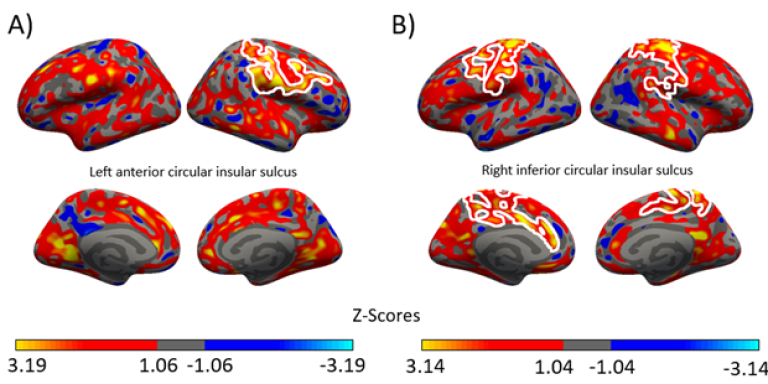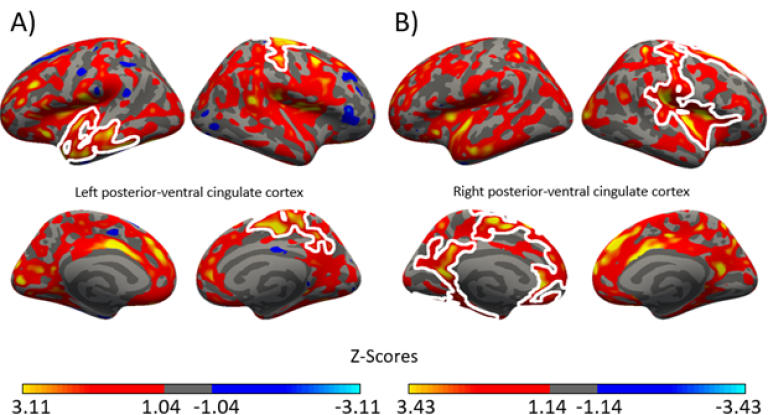Repeated ayahuasca use increases structural covariance in networks associated with ‘self’ processing
Alex C Piot, José C Bouso, Draulio de Araujo, and Jeremy I. Skipper
Introduction
Little is known about the consequences of long-term use of psychedelic drugs and attendant effects on brain structure. Previous work in a population of repeated ayahuasca users observed minimal changes in cortical thickness compared to matched controls except in the cingulate cortex, changes that correlated with behavioural metrics associated with the ‘self’ (Bouso et al., 2015). Indeed, a number of other ayahuasca studies have demonstrated changes in self related measures after long-term use (e.g.,)(dos Santos et al., 2016). However, the ‘self’ is a multidimensional construct that can be grossly characterised as comprising an embodied and narrative self (Millière, 2017; Millière et al., 2018). The former is more related to interoception and somatosensation and associated brain regions (e.g., the insula and postcentral gyrus). In contrast, the narrative self is more related to the interrelationship between autobiographical memory, associated with nodes in the default mode network (DMN; e.g., the cingulate), and language, associated with, e.g., the transverse temporal gyrus (TTG) and superior temporal gyrus (STG)(Skipper, 2022). Given that structural and functional changes can mirror one another (e.g.,)(Draganski et al., 2004; Maguire et al., 2000), we hypothesised that the cortical thickness in regions comprising networks involved in the embodied and narrative self would covary more following long-term ayahuasca use compared to controls.
Methods
Ayahuasca users (AYA; N = 22) consumed ayahuasca at least 50 times over the previous two years. Psychedelic-naive control participants (CON; N = 22) were matched on sex, age, years of education, verbal IQ, and fluid IQ. Structural magnetic resonance images were acquired on a 3-T scanner using a T1-weighted MPRAGE acquisition sequence. General linear models (GLMs) were constructed in Freesurfer using the volumes of regions of interest associated with the embodied (e.g. the insula) and narrative self (e.g., cingulate and TTG) and participants as covariates (AYA or CON). GLMs were implemented with the mri_glmfit command. Cluster size correction was performed with the mri_glmfit-sim command (vertex-wise cluster threshold of p = 0.05, cluster-wise threshold of p = 0.05, 10,000 permutations). An additional Bonferonni correction was implemented because analyses were conducted on each hemisphere individually.
Results
The insula, a region of interest chosen because of its association with the embodied self, showed more positive covariation in the AYA compared to the CON group in, most prominently, the postcentral gyrus, precuneus, and posterior cingulate (Figure 1, “warm” colors, with white outlines corresponding to statistically significant clusters).



Conclusions
Results suggest that repeated ayahuasca use results in structural changes to networks associated with the embodied and narrative self in a relatively independent/separable manner, with some overlap in posterior nodes of the DMN. This implies that long-term psychedelic drug use might change both how people feel within their bodies as embedded in the world (the embodied self) and the way that they talk to and about themselves (the narrative self). More generally, results imply a previously unacknowledged role of the neurobiology of language in the incorporation of psychedelic experiences over long periods of time, perhaps leading to the suggested improvements in mental health and wellbeing associated with psychedelic drugs (Skipper, 2022).
References
Bouso, J. C., Palhano-Fontes, F., Rodríguez-Fornells, A., Ribeiro, S., Sanches, R., Crippa, J. A. S., Hallak, J. E. C., de Araujo, D. B., & Riba, J. (2015). Long-term use of psychedelic drugs is associated with differences in brain structure and personality in humans. European Neuropsychopharmacology: The Journal of the European College of Neuropsychopharmacology, 25(4), 483–492.
dos Santos, R. G., Balthazar, F. M., Bouso, J. C., & Hallak, J. E. C. (2016). The current state of research on ayahuasca: A systematic review of human studies assessing psychiatric symptoms, neuropsychological functioning, and neuroimaging. Journal of Psychopharmacology , 30(12), 1230–1247.
Draganski, B., Gaser, C., Busch, V., Schuierer, G., Bogdahn, U., & May, A. (2004). Neuroplasticity: changes in grey matter induced by training. Nature, 427(6972), 311–312.
Maguire, E. A., Gadian, D. G., Johnsrude, I. S., Good, C. D., Ashburner, J., Frackowiak, R. S., & Frith, C. D. (2000). Navigation-related structural change in the hippocampi of taxi drivers. Proceedings of the National Academy of Sciences of the United States of America, 97(8), 4398–4403.
Millière, R. (2017). Looking for the Self: Phenomenology, Neurophysiology and Philosophical Significance of Drug-induced Ego Dissolution. Frontiers in Human Neuroscience, 11, 245.
Millière, R., Carhart-Harris, R. L., Roseman, L., Trautwein, F.-M., & Berkovich-Ohana, A. (2018). Psychedelics, Meditation, and Self-Consciousness. Frontiers in Psychology, 9, 1475.
 Close
Close

